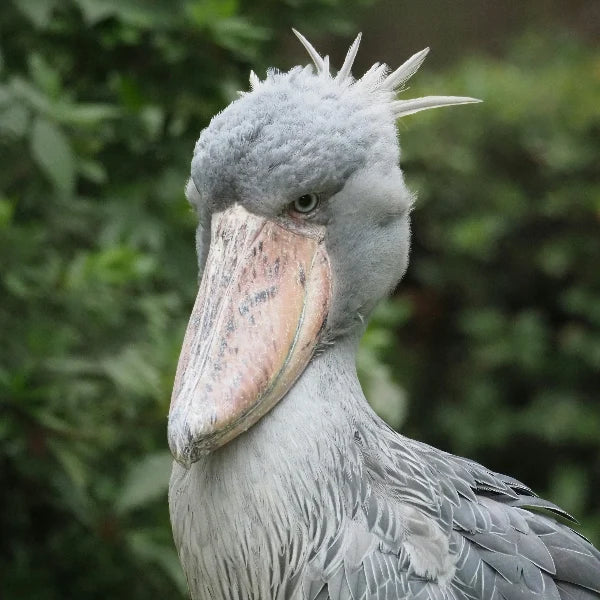Introduction
The Shoebill Stork( Balaeniceps rex) is a famous bird named for its beak shape! It is a large bird usually found in Africa. It is popular for its unique features, especially the beak, which looks like a shoe. The most fascinating thing about the Shoebill Stork is its dinosaur-like appearance, which has led it to be considered a descendant of dinosaurs. Additionally, it can remain still and motionless for hours, so people often mistake it for a statue. Overall, its striking features and unique traits make it one of the most extraordinary birds on Earth.
Also known as the whale-headed stork, the Shoebill’s beak is not just unusual—it plays a crucial role in hunting and holding prey. Its shape allows the bird to grip even slippery prey, such as fish and baby crocodiles, with a strong, precise hold. The sharp hook of the Shoebill's beak helps it secure its meal with precision. With so many fascinating adaptations, there’s more to discover—explore the article to learn more about the Shoebill Stork!

Physical Characteristics of the Shoebill
One of the most notable physical features of the Shoebill Stork is its height. So how tall is a Shoebill Stork? They typically stand between 3.6 and 4.5 feet, making them one of the tallest birds in their wetland habitats. And how big is a Shoebill Stork overall? In addition to their height, Shoebills weigh around 11–12 pounds on average and have a wingspan of 7.5–8.5 feet. Their large size, combined with a broad, powerful beak, gives them a commanding presence and makes them instantly recognizable among other birds.
The Shoebill also has unique behavioral traits. It can remain motionless for long periods, tricking other animals into thinking it is a statue. Storks prefer to hunt alone rather than in groups and love to trap animals by staying long at the same place before striking.
Where Does the Shoebill Stork Live
The Shoebill Stork’s habitat is mostly wetlands near freshwater cascades. Its distribution is limited to East African countries like Uganda, South Sudan, Tanzania, and Zambia. Their survival is usually only possible in wetlands, where they can enjoy hunting, nesting, breeding, and food-finding activities.
Shoebills are an endangered species due to deforestation and habitat destruction. Illegal hunting and illegal pet trade have pushed the Shoebill Stork toward vulnerability. In 2016, only about 3,300–5,300 mature individuals remained in the wild, down from 5,000–8,000 in 2008, according to Audubon. The number of these birds is decreasing rapidly, and there is great fear of their extinction.

Conservation Status and Efforts
Due to fear of extinction, many organizations are trying to conserve this unique bird named for its beak shape. The Bangweulu Wetlands in Zambia is one of the known sites for the conservation of the Shoebill. Moreover, various organizations have launched educational programs to educate people about animal conservation and prevent illegal hunting or pet trading. Organizations like African Parks and BirdLife International are significant in these initiatives.
Despite ongoing conservation efforts, shoebills still face major challenges due to illegal hunting, the pet trade, and widespread habitat loss. Industrialization, agricultural expansion, climate change, and other human activities have severely degraded wetlands, threatening the habitats that shoebills rely on. These wetland ecosystems provide the most suitable environment for the species, and without them, survival becomes extremely difficult. Although shoebills are relatively weak fliers, they depend on large wetland areas that provide enough space for hunting and breeding.

Photo by Mehmet Karatay, via Wikimedia Commons, licensed under CC BY-SA 4.0.
Behavior and Diet of the Shoebill Stork
Shoebills are the perfect hunters. They believe in the wait-and-hit technique for catching their prey. Their unique hunting skills allow them to stay still until they are sure they have captured the prey. Whether they have to eat, find, or hunt, Shoebill Storks are highly dependent on their shoe-shaped beaks. Their big beaks can capture fish from the pond while shaking off the excessive water.
Unlike many other bird species, Shoebill Storks prefer solitude. They rarely interact with other species. Also, while raising chicks, the survival of chicks is highly dependent on their activity and dominance.
Interested in other birds with unusual habits? You might enjoy learning about the Potoo — a master of camouflage and stillness that rivals even the Shoebill in mysterious behavior.
Shoebill's Role in the Ecosystem
Shoebills help maintain balance in the ecosystem by controlling fish and amphibian populations. Their presence and interaction with other animals increase the charm of wetlands. These birds are also called incubator species as they depend on unpolluted wetlands to ensure environmental health.

Shoebill Stork in Culture and Media
The stork is a famous bird due to its rich cultural history. Due to its enormous size, people of many religions consider it sacred and precious. People have associated it with various concepts and symbols, such as strong will and power. Its massive size and unique hunting style have also led people to link it to patience, silent strength, and protection. Due to its large beak and still expressions with intense stares, it has become popular in myths, cultural beliefs, and modern media.
- Shoebill Stock has been given great importance in literature, and many tales have been created based on its traits.
- Many African cultures respect the Shoebill for its stillness and patience. It symbolizes wisdom, patience, and intelligence, making it a symbol of deep thinking and strategy.
- These rare birds are also considered mysteries. Due to their strange appearance and quiet nature, people believe they are messengers or spirit birds. People also believe that seeing a Shoebill is a sign of luck and charm.

The Popularity of Shoebill Stork
The Shoebill Stork has gained global attention in recent years thanks to modern media. Documentaries, in-depth videos, and detailed articles about the Shoebill Stork are widely available online. This unique bird has been featured on major channels such as National Geographic, BBC Earth, and the Discovery Channel. Many videos showcase Shoebill Storks patiently waiting to catch their prey for hours, highlighting their haunting and dramatic hunting behavior.
Recent News and Updates
Recent reports indicate that Uganda is home to fewer than 200 Shoebill Storks in the wild, with some estimates suggesting as few as 100–150 individuals remaining. This dramatic decline has raised significant concerns among conservationists about the species’ future. 
In response to this alarming situation, various conservation initiatives are underway. For instance, the “Save the Shoebill” project is actively funding locally led efforts to protect these iconic birds and their wetland habitats. Their approach includes community engagement and habitat preservation strategies. 
Additionally, the Bangweulu Wetlands in Zambia have become a focal point for Shoebill conservation. Collaborative efforts have led to the employment of local community members to monitor and protect Shoebill nests, ensuring the survival of this unique species. 
These concerted conservation actions are vital in reversing the decline of the Shoebill Stork and ensuring its survival for future generations.

Amazing Facts About the Shoebill Stork
- Shoebill Storks often live up to 35–36 years in the wild, and some reports claim they may reach up to 50 years in captivity.
- Their massive beaks can measure up to about 24 cm (9.4 in), perfectly suited for catching prey like lungfish and baby crocodiles.
- With striking pale blue or grayish-yellow eyes, Shoebills are known for their intense, motionless stare while hunting.
- These solitary birds fiercely defend their territories, often spanning several square kilometers.
- Though usually very quiet, Shoebills produce bill-clattering sounds—often likened to a machine gun—during courtship or when interacting with mates.
Conclusion
The Shoebill Stork is one of the biggest and most unique birds of its type. Its distinctive features and hunting instincts make it popular and mysterious. These birds have great importance in history, culture, and literature. In several African cultures, the Shoebill symbolizes patience and wisdom, reflecting its calm and solitary nature.
These are not social birds; they like to stay alone. While they’ve gained global attention through media and zoos, the species is classified as Vulnerable by the IUCN Red List.
Only a few thousand shoebill storks remain in the world, and they are highly sought after. Many organizations, including IUCN, are working on their conservation. However, since they can only reproduce one chick at a time and require a vast habitat, their survival remains highly challenging. Some birds are kept safe in zoos, so these species may last longer.
If you’re fascinated by birds with striking appearances, don’t miss our feature on the Macaroni Penguin — a tuxedoed ocean dweller with a golden crest and a flair for drama.

FAQs About the Shoebill Stork
Are there any shoebills in the USA?
Shoebills are not native to the United States. However, a few zoos in the U.S. house shoebills for conservation and education purposes. In recent years, Dallas World Aquarium in Texas has exhibited Shoebill Storks in its collection. ZooTampa at Lowry Park in Florida currently houses two Shoebills.
Are Shoebill Storks friendly to humans?
Shoebill Storks are not friendly to humans. They prefer to keep their distance and may stare intently, which can seem intimidating. Observing them from a safe distance in zoos or wildlife reserves is the best way to appreciate their unique appearance and behavior.
What is a 5 foot tall bird that eats crocodiles?
The Shoebill Stork is a massive bird that can stand around 5 feet tall and is known for its impressive hunting skills. Native to East African wetlands, it uses its large, powerful beak to catch fish, lungfish, and even baby crocodiles.
Why does only one offspring of the Shoebill Stork survive?
Shoebill storks prioritize their eldest chick and ignore the younger ones. So, the egg that gets hatched first gets the chance to survive, and it may kill the other eggs to steal the attention.
Is shoebill stork a dinosaur?
No, the Shoebill Stork is not a dinosaur, but its large beak, tall stature, and slow, deliberate movements give it a prehistoric, dinosaur-like appearance.
Can a shoebill be a pet?
Keeping a Shoebill Stork as a pet is illegal. The bird is enormous and has large wings, so it requires a proper living area.




Leave a comment
All comments are moderated before being published.
This site is protected by hCaptcha and the hCaptcha Privacy Policy and Terms of Service apply.